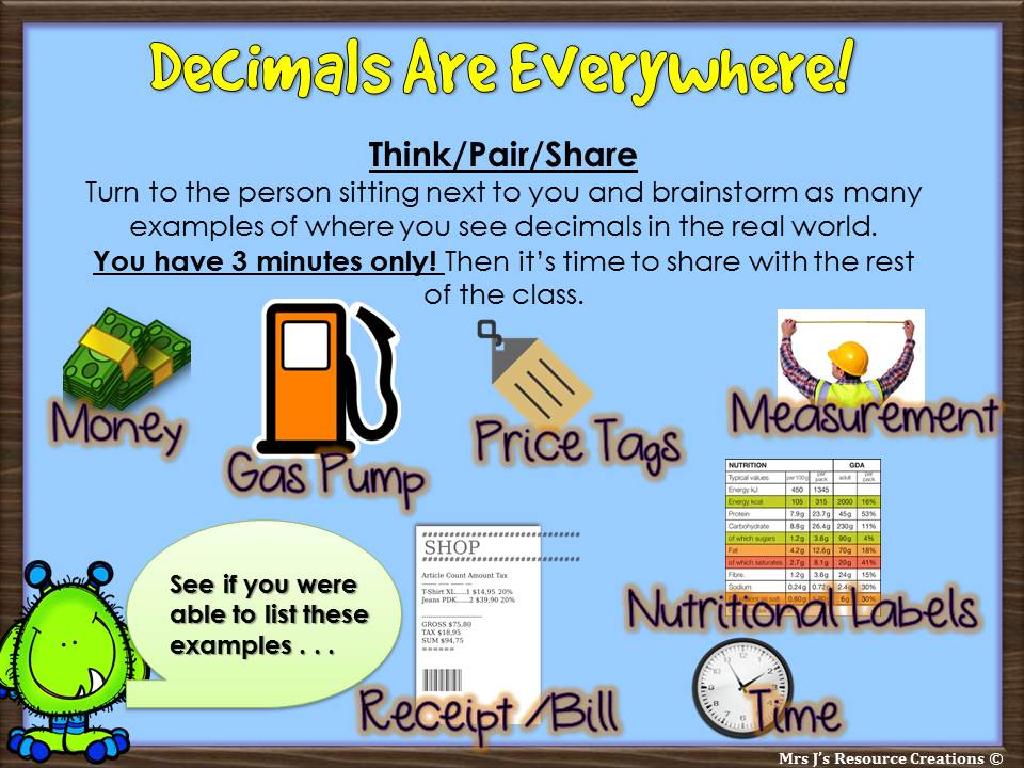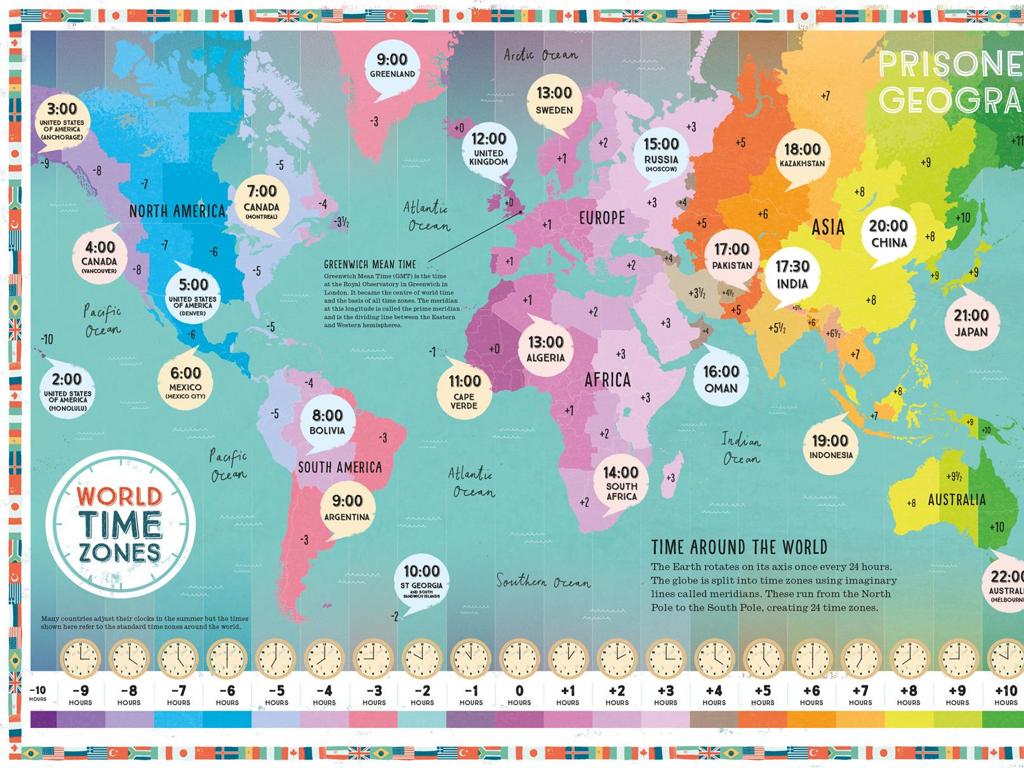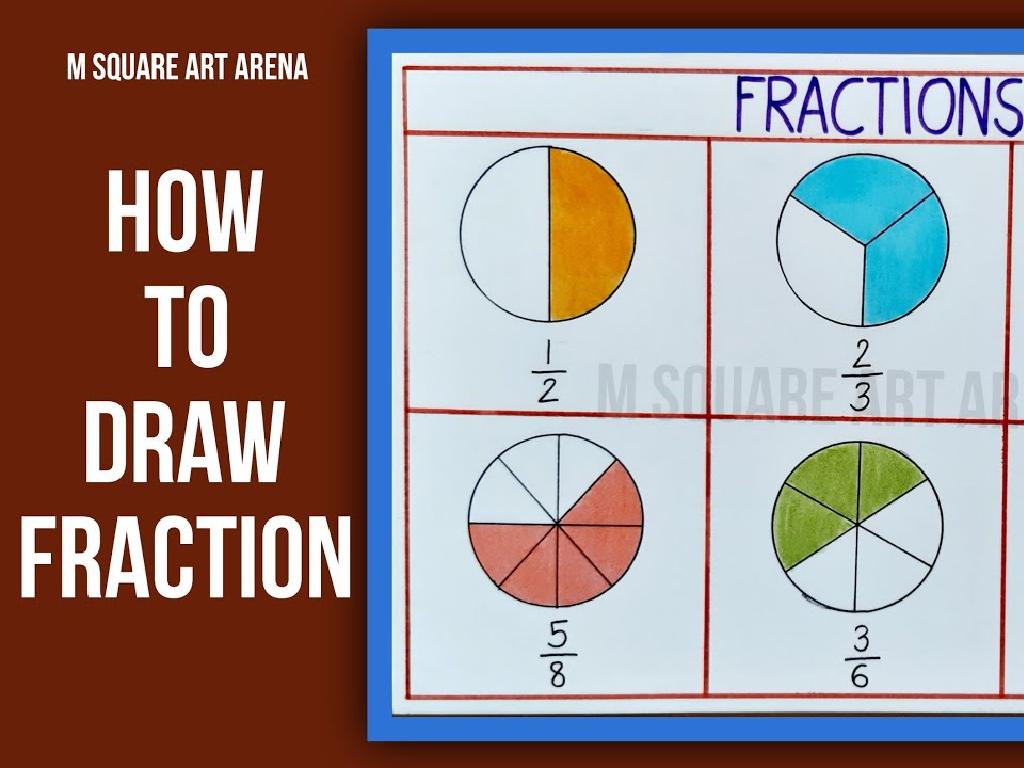Write Variable Expressions For Arithmetic Sequences
Subject: Math
Grade: Seventh grade
Topic: Sequences
Please LOG IN to download the presentation. Access is available to registered users only.
View More Content
Welcome to Sequences!
– Patterns and sequences in math
– Defining an arithmetic sequence
– A sequence with a constant difference between terms
– Identifying the common difference
– The steady increment between numbers in the sequence
– Writing expressions for sequences
– Use the formula a_n = a_1 + (n-1)d to express sequences
|
This slide introduces students to the concept of sequences in mathematics, focusing on arithmetic sequences. Begin by discussing patterns and how they form sequences. Explain that an arithmetic sequence is a list of numbers with a specific, constant difference between consecutive terms. Emphasize the importance of the common difference and how it can be found by subtracting any term from the following term. Conclude by showing how to write variable expressions for arithmetic sequences using the formula, where ‘a_n’ represents the nth term, ‘a_1’ is the first term, ‘n’ is the term number, and ‘d’ is the common difference. Provide examples and encourage students to practice with different sequences to solidify their understanding.
Identifying Arithmetic Sequences
– Defining an arithmetic sequence
– A sequence with a constant difference between terms
– Consistent patterns in sequences
– Look for a regular addition or subtraction pattern
– Real-life arithmetic sequence examples
– Daily savings, stair steps, clock intervals
– Writing expressions for sequences
|
This slide introduces students to the concept of arithmetic sequences, which are sequences of numbers with a constant difference between consecutive terms. Emphasize the pattern recognition aspect by adding or subtracting the same value, which is a key characteristic of arithmetic sequences. Provide relatable examples such as adding money to a savings account daily or the consistent increase in steps on a staircase. Encourage students to think of other examples from their daily lives. Conclude by explaining how to write variable expressions for these sequences, preparing them for creating their own sequences and understanding their applications.
Writing Variable Expressions for Sequences
– Define variable expression
– A mathematical phrase involving numbers, operations, and variables, like ‘n’.
– Introducing ‘n’ as a variable
– ‘n’ often represents the position of a term in a sequence.
– General form of arithmetic sequence
– An arithmetic sequence has the form a_n = a_1 + (n-1)d.
– Creating expressions with ‘n’
– For example, for the sequence 2, 4, 6, 8, the expression is 2 + (n-1)2.
|
This slide introduces students to the concept of variable expressions in the context of arithmetic sequences. Begin by explaining what variable expressions are and how they are used in mathematics to represent numbers in a general way. Introduce ‘n’ as a common variable used to represent the position of a term in a sequence. Discuss the general form of an arithmetic sequence, which is a_n = a_1 + (n-1)d, where a_n is the nth term, a_1 is the first term, and d is the common difference between terms. Provide examples of how to create variable expressions using ‘n’ for different arithmetic sequences. Encourage students to practice writing their own expressions for sequences they come up with.
Constructing Expressions for Arithmetic Sequences
– Find the first term (a1)
– The first number in the sequence
– Determine the common difference (d)
– The difference between consecutive terms
– Write the expression for nth term
– Use a_n = a1 + (n-1)d to find any term
– Practice with examples
– Apply the formula to different sequences
|
This slide is aimed at teaching students how to write variable expressions for arithmetic sequences. Start by identifying the first term of the sequence, which is crucial as it is the starting point. Next, determine the common difference by subtracting any term from the term that follows it. With these two pieces of information, students can write the expression for the nth term of the sequence using the formula a_n = a1 + (n-1)d. It’s important to provide several examples and allow students to practice constructing expressions for different sequences to solidify their understanding.
Arithmetic Sequences: Practice Examples
– Example 1: Find the expression
– Given a sequence, write its variable expression
– Example 2: Create a sequence
– Invent an arithmetic sequence and its expression
– Discuss solutions in groups
– Exchange ideas and clarify doubts within the group
– Share findings with the class
|
This slide is aimed at reinforcing the students’ understanding of arithmetic sequences through hands-on practice. Example 1 should be a guided walk-through of finding the variable expression for a given arithmetic sequence. For Example 2, encourage creativity as students create their own sequences and corresponding expressions. Group discussions will allow students to collaborate and learn from each other, enhancing their problem-solving skills. Conclude with a session where groups share their sequences and expressions with the class, fostering a collaborative learning environment. The teacher should circulate to offer assistance and ensure that each group is on task and understanding the concepts.
Class Activity: Sequence Scavenger Hunt
– Find real-life arithmetic sequences
– Write variable expressions for sequences
– Use the formula a_n = a_1 + (n-1)d, where ‘d’ is the common difference
– Share your findings with the class
– Discuss the relevance of sequences
|
This interactive class activity encourages students to explore their environment and identify arithmetic sequences in real life, such as steps on a staircase or petals on flowers. Once they find a sequence, they should write the variable expression for it using the formula for the nth term of an arithmetic sequence. Students will then share their findings with the class, fostering a discussion on how arithmetic sequences appear in everyday life. For the teacher: Prepare to guide students on how to write variable expressions and provide examples. Possible activities include measuring the height of stacked books, counting seats in rows, or observing traffic light patterns. Encourage students to explain their reasoning and how they determined the common difference in their sequences.
Wrapping Up: Arithmetic Sequences
– Recap of variable expressions
– Homework: 5 sequences & expressions
– Create and write expressions for 5 different arithmetic sequences.
– Next class: Solving specific terms
– We’ll learn to find any term in a sequence.
– Review today’s concepts
– Go over your notes and try additional problems.
|
As we conclude today’s lesson on writing variable expressions for arithmetic sequences, remind students of the key points covered. For homework, they should create five unique arithmetic sequences and write the corresponding variable expressions. This will help reinforce their understanding of the concept. Looking ahead, the next class will focus on solving for specific terms within a sequence, which is a crucial skill for understanding patterns in math. Encourage students to review the material from today’s lesson and practice additional problems to prepare for the upcoming class.





